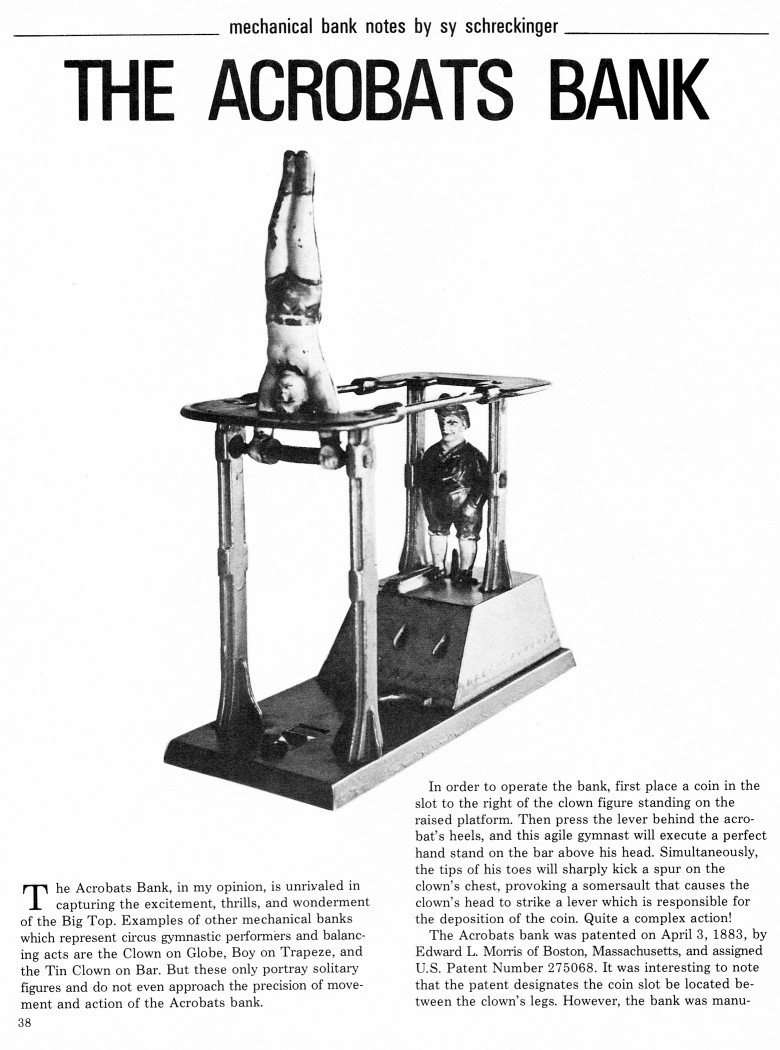|
The Acrobats Bank
by Sy Schreckinger – ANTIQUE TOY WORLD Magazine – January,
1983
The Acrobats Bank, in my opinion,
is unrivaled in capturing the excitement, thrills, and wonderment of the
Big Top. Examples of other mechanical banks which represent circus
gymnastic performers and balancing acts are the Clown on Globe, Boy on
Trapeze, and the Tin on Bar. But these only portray solitary Figures and
do not even approach the precision of movement and action of the Acrobats
bank.
In order to operate the bank, first place a coin in the slot to the
right of the clown figure standing on the raised platform. Then press the
lever behind the acrobat's heels, and this agile gymnast will execute a
perfect hand stand on the bar above his head. Simultaneously, the tips of
his toes will sharply kick a spur on the clown's chest, provoking a
somersault that causes the clown's head to strike a lever which is
responsible for the deposition of the coin. Quite a complex action!
The Acrobats bank was patented on April 3, 1883, by Edward L. Morris of
Boston, Massachusetts, and assigned U.S. Patent Number
275,068. It was
interesting to note that the patent designates the coin slot be located
between the clown's legs. However, the bank was manufactured with the coin
slot on the outside, adjacent to his right leg (fig. 1).
The Acrobats bank is fastened together entirely with rivets and
riveted tabs; no screws are used. Thus, it is quite easy to tell whether
any repairs have been made or a part has been replaced. One part, in
particular, which usually shows up broken, is the hands of the gymnast. It
is an extremely delicate casting and, because of the bank's strong spring,
usually fails when placed tinder great stress and shock.
The Acrobats was produced in two color schemes. However, variations
in color are limited to parts of the bank other than the figures
themselves. On all banks, the clown has pink skin, black eyes and
eyebrows, and red mouth. His shirt is blue with a yellow collar. He sports
red knickers, white stockings and shiny black shoes. Perched upon his head
is a bright red and orange hat. The acrobat wears a white leotard top and
tights, and these are outlined in dark blue. His trunks and boots are red
and he has a wide, black belt. His face and hands are pink, while his
hair, eyebrows, eyes and suave, handlebar moustache are black. The color
variations are: one type has a dark blue base, tan support posts and a
blue top with yellow stripes. The raised platform is red with a tan
sawtooth design at the lower half.
The banks also vary mechanically. Some have a small raised stop just
behind the left heel of the clown. The purpose was to prevent the heel of
the figure from accidentally hitting the lever and depositing the coin
prematurely.
The Acrobats bank has been reproduced and, because of this fact, I
have included a base diagram indicating its exact size (fig. 2). A
reproduction will measure approximately 1/8 inch smaller along the base
than the original bank. This is due to the shrinkage of the molten iron
after it cools.
The Acrobats is extremely difficult to locate in all-original,
unbroken condition, and is to be considered quite rare when found with
superb paint.
In conclusion, I once again caution purchasers of
antique mechanical banks to be wary of reproductions. Knowledge and
awareness of their existence are probably the collector’s greatest assets
in avoiding frustrating and costly purchasing errors.
|


